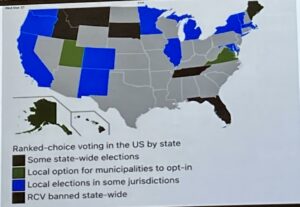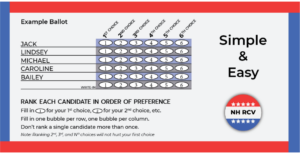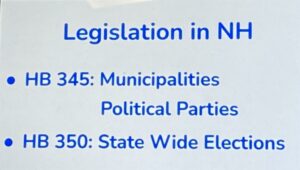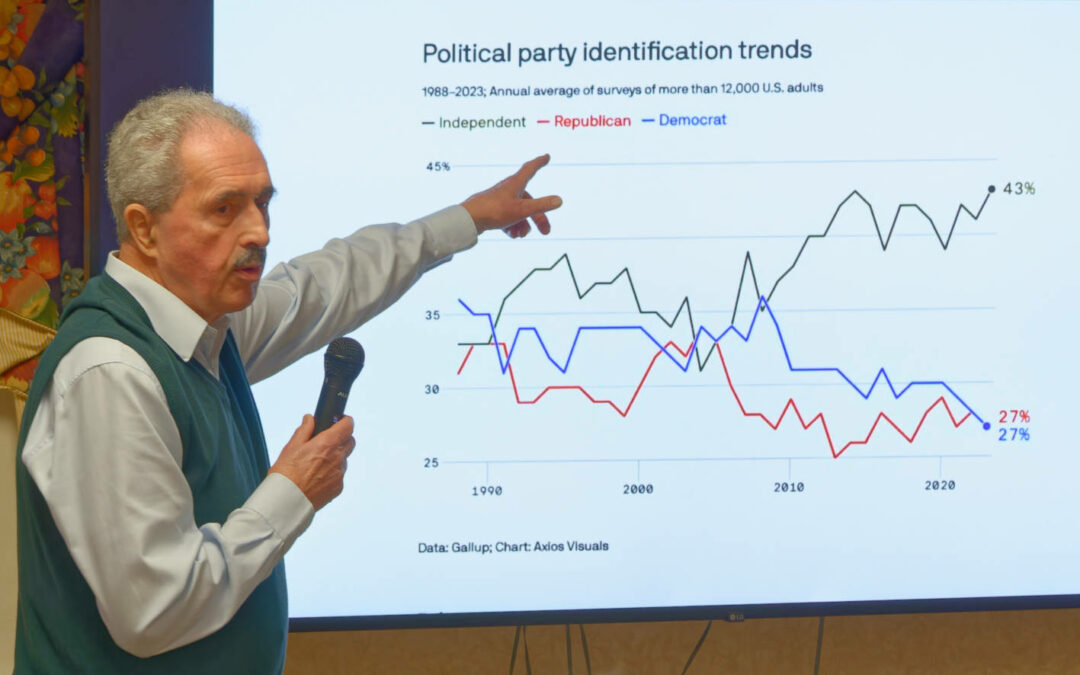Our speaker today was Bruce Garland. He educated us about Ranked choice voting (RCV).
Some of the info below comes from the NH Ranked Choice Voting webpage.
He began his talk having asking us reflect back to the Democrat Convention in 1968. At that time, many had concerns that the process of selecting the democrat candidate for president. Many thought the process wasn’t transparent and many deemed it unacceptable. This then led to changes in primary elections and the primary system we have today.
Today, we talk about having two-parties, republican and democrat, but republicans registered voters are only 27% of registered voters, the same is true of democrats (27%) with 43% declaring they are independents and the gap keeps growing.
He reviewed a variety of states that have some portion of their elections done by rank choice voting. The most recent was in California for the senate primary. Other states the use some form of RCV include Nevada, Maine, Alaska, Colorado, New Mexico, Minnesota, Illinois, New York, Virginia, Delaware, Massachusetts and Washington.

SO WHAT IS RANK CHOICE VOTING?
RCV describes voting systems that allow voters to rank candidates in order of preference, and then uses those rankings to elect candidates who best represent their constituents.
Here is what a sample ballot might look like:
Bruce described RCV as being a straightforward system for voters: rank candidates in order of choice. Voters can rank as many candidates as they want, without fear that ranking others will hurt the chances of their favorite candidate.
How the votes are counted depends on whether RCV is used to elect a single office, like a governor, or whether it is used to elect more than one position at once, like an at-large city council or a state legislature elected in a multi-winner district.
He outlined what he considered the benefits of this system of voting:
- Ends the “Spoiler Effect” — where similar candidates split the vote, throwing the election to a less popular candidate
- Curbs Negative Campaigning — by focusing on what unites us as opposed to what divides us
- Enables Every Vote to Count — in determining the election’s winner(s)
- Eliminates Strategic Voting — allowing you to vote your preference, not just who you think might win
- Ensures Winners with Broad Support
- Single Member Districts — The winner earns more than 50% of the vote or has the most votes after all rounds are counted
- Multi-Member Districts — Does away with block-voting and one-party sweeps, and leads to more proportional representation. (Majority factions get a majority of seats, but not necessary all seats)
Bruce indicated that with the advent of computers, RCV is easier to manage at the local and state level. NH is in the process of upgrading voting computers that could handle this type of voting. Here is an example of a RCV ballot:

He then let us know that in NH two bills are winding their way through the legislature. If you want to learn more about them go the NH legislative webpage.



Recent Comments